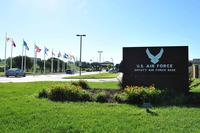RAF Lakenheath, UK -- The Air Force is preparing to station its first permanent F-35 squadrons in the UK, and planners are already looking to a sister service for insights on how to train and operate in new ways with European allies.
In 2021, the first of roughly 54 F-35As is set to land here, about 80 miles northeast of London. Construction is underway on two hangars and a six-bay simulator, as well as other infrastructure for training and maintenance on the stealth fighter. Despite the COVID-19 pandemic, the planes' planned November arrival is still on schedule, Lt. Col. Derek "Ajax" Syswerda, director of staff for the 48th Fighter Wing, said in an interview this month.
And with the UK's F-35B fighters already stationed a mere 25 miles north at RAF Marham, Syswerda said he expects the American jets to be part of a much larger picture of joint operations with peer aircraft.
Read Next: Biden Taps Kathleen Hicks to Be the Pentagon's First Female Deputy SecDef
"The U.S. is going to have about 50 jets here. We have a bunch of different partners, that's changing all the time ... we just added Poland," he said. "And the theater is going to have something like 500 [F-35] jets in it. So if we can't operate with those countries, we can't as effectively go to war."
During Acting Defense Secretary Christopher C. Miller's visit to Lakenheath and nearby RAF Mildenhall before Christmas, he received a classified briefing on a historic joint operation already in planning: the deployment of a squadron of Marine Corps F-35B Joint Strike Fighters aboard a British aircraft carrier, the Queen Elizabeth, in 2021. On the ship, the Marine Corps jets will operate alongside British F-35s, which are also in the short takeoff/vertical landing B-variant.
""HMS Queen Elizabeth will be operating with the largest air group of 5th-generation fighters assembled anywhere in the world," Commodore Steve Moorhouse, commander of the U.K. carrier strike group, said in a September statement. "Led by the Royal Navy, and backed by our closest allies, this new Carrier Strike Group puts real muscle back into NATO; and sends a clear signal that the United Kingdom takes its global role seriously."
Syswerda said the Air Force was watching those efforts closely.
"That's where we want to get to," he said. "That's awesome that the Marine Corps kind of set that tone for us; it's difficult for us to work directly with other countries."
Operating the F-35 within the UK presents other challenges for the Air Force, too; the simulators under construction at Lakenheath will provide a greater-than-typical proportion of pilot training, due to the smaller footprint and security restrictions in the region. Ultimately, the base is expected to have all 54 Air Force jets by 2023, joining a growing force of F-35s across Europe. As of the start of this year, there were 60 F-35s based on the continent, none of them American.
"I dream of it being a deterrent; that's the massive goal, is that it's a Day One fighter," Syswerda said. "For our adversaries in this theater, I see it being a deterrent. So hopefully we never actually have to use it."
-- Hope Hodge Seck can be reached at hope.seck@military.com. Follow her on Twitter at @HopeSeck.
Related: In First, US F-35 Fighters Deploy Aboard British Carrier















